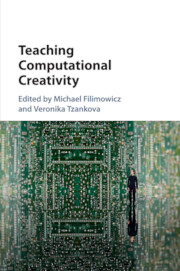Book contents
- Teaching Computational Creativity
- Teaching Computational Creativity
- Copyright page
- Contents
- Figures
- Tables
- Notes on Contributors
- Acknowledgments
- Introduction: Pedagogies at the Intersection of Disciplines
- PART I NEW FOUNDATIONS
- 1 Staying Current: Developing Digital Literacies for the Creative Classroom
- 2 Teaching Interactivity: Introducing Computation to Art/Design Students
- PART II CODE AS MEDIUM
- PART III PHYSICAL{LY} COMPUTING
- PART IV ONLINE LEARNING
- PART V CRITICAL PEDAGOGY
- PART VI TRANSDISCIPLINARY
- Interviews
- Afterword: Toward a Curricular Synthesis
- Index
- References
2 - Teaching Interactivity: Introducing Computation to Art/Design Students
from PART I - NEW FOUNDATIONS
Published online by Cambridge University Press: 04 July 2017
- Teaching Computational Creativity
- Teaching Computational Creativity
- Copyright page
- Contents
- Figures
- Tables
- Notes on Contributors
- Acknowledgments
- Introduction: Pedagogies at the Intersection of Disciplines
- PART I NEW FOUNDATIONS
- 1 Staying Current: Developing Digital Literacies for the Creative Classroom
- 2 Teaching Interactivity: Introducing Computation to Art/Design Students
- PART II CODE AS MEDIUM
- PART III PHYSICAL{LY} COMPUTING
- PART IV ONLINE LEARNING
- PART V CRITICAL PEDAGOGY
- PART VI TRANSDISCIPLINARY
- Interviews
- Afterword: Toward a Curricular Synthesis
- Index
- References
Summary
I teach undergraduate and graduate art/design students how to create expressive interactive experiences such as digital games, interfaces, art installations, and mobile applications. A core skill they need to acquire is computational literacy, which is a two-step process. The first step requires an ability to understand and modify code. The second step translates ideas and concepts into code. The transition from the first to second step is challenging for many students. The majority of my students have an art background but little or no knowledge of programming. Despite their passion for interactive media, students are often put off by the relatively steep learning curve of programming. Regardless of the topic I teach, my courses are structured around a series of assignments of varying length (1–6 weeks). Students learn programming by developing projects for these assignments either individually or in small teams. To motivate students and better help them understand the interactive design process, projects are always based on students’ original ideas. In this chapter, I describe how this process takes place in the courses I teach by looking at the work of three students.
- Type
- Chapter
- Information
- Teaching Computational Creativity , pp. 48 - 72Publisher: Cambridge University PressPrint publication year: 2017



